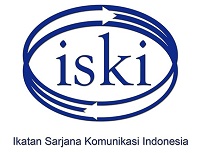Sadfishing Phenomenon of #Justiceforaudrey (Hashtag) on Twitter
Abstract
Keywords
Full Text:
PDFReferences
Abraham, A. (2019). Kendall Jenner and Instagram influencers are being blamed for a so-called new phenomenon and trend. Diambil 21 November 2019, dari https://www.dazeddigital.com/life-culture/article/46280/1/sadfishing-young-people-online-kendall-jenner-take-seriously
Al-Rawi, A. (2019). Viral News on Social Media. Digital Journalism, 7(1), 63–79. https://doi.org/10.1080/21670811.2017.1387062
Baron-Cohen, S., & Wheelwright, S. (2004). The empathy quotient: An investigation of adults with asperger syndrome or high functioning autism, and normal sex differences. Journal of Autism and Developmental Disorders, 34(2), 163–175. https://doi.org/10.1023/B:JADD.0000022607.19833.00
Cahyono, A. S. (2016). Pengaruh Sosial Media Terhadap Perubahan Sosial Masyarakat di Indonesia. Publiciana, 9(1), 140–157.
Hidaya, N., Qalby, N., Alaydrus, S. S., Darmayanti, A., & Salsabila, A. P. (2019). Pengaruh Media Sosial Terhadap Penyebaran Hoax Oleh Digital Native. Diambil 23 Januari 2020, dari https://www.researchgate.net/profile/Nurul_Hidayaa/publication/330135181_PENGARUH_MEDIA_SOSIAL_TERHADAP_PENYEBARAN_HOAX_OLEH_DIGITAL_NATIVE/links/5c2f44a1a6fdccd6b59089d3/PENGARUH-MEDIA-SOSIAL-TERHADAP-PENYEBARAN-HOAX-OLEH-DIGITAL-NATIVE.pdf
Jargon, J. (2019). Sadfishing, Predators and Bullies: The Hazards of Being ‘Real’ on Social Media. Diambil 20 November 2019, dari https://www.wsj.com/articles/sadfishing-predators-and-bullies-the-hazards-of-being-real-on-social-media-11573554603
Jatmiko, M. I. (2019). Post-Truth, Media Sosial, Dan Misinformasi: Pergolakan Wacana Politik Pemilihan Presiden Indonesia Tahun 2019. Jurnal Dakwah Tabligh, 20(1), 21. https://doi.org/10.24252/jdt.v20i1.9529
Mulyana, D. (2008). Metode Penelitian Kualitatif: Paradigma Baru Illmu Komunikasi dan Ilmu Sosial Lainnya. Bandung: Remaja Rosdakarya.
Nummenmaa, L., Hirvonen, J., Parkkola, R., & Hietanen, J. K. (2008). Is emotional contagion special? An fMRI study on neural systems for affective and cognitive empathy. Neuroimage, 43, 571–580. https://doi.org/10.1016/j.neuroimage.2008.08.014
Pawito. (2007). Penelitian Komunikasi Kualitatif. Yogyakarta: LKIS Pelangi Aksara.
Pöyry, E., Laaksonen, S.-M., Kekkonen, A., & Pääkkönen, J. (2018). Anatomy of Viral Social Media Events. In Proceedings of the 51st Hawaii International Conference on System Sciences (Vol. 9). https://doi.org/10.24251/hicss.2018.272
Preston, S. D., & Hofelich, A. J. (2012). The Many Faces of Empathy: Parsing Empathic Phenomena through a Proximate, Dynamic-Systems View of Representing the Other in the Self. International Society For Research on Emotion, 4(1), 24–33. https://doi.org/https://doi.org/10.1177/1754073911421378
Putri, W. S. R., Nurwati, N., & Budiarti, M. (2016). Pengaruh Media Sosial Terhadap Perilaku Remaja. In Prosiding Penelitian dan Pengabdian kepada Masyarakat (Vol. 3, hal. 47–51). https://doi.org/10.24198/jppm.v3i1.13625
Salim, A. (2006). Teori dan Paradigma penelitian social. In buku sumber untuk penelitian kualitatif, Yogyakarta, Tiara Wacana,.
Staiou, E., & Giannakoulopoulos, A. (2018). A Case Study on Viral Journalism in Greece: The Figures, The Trends And The Factors of Success. Journal of Media Critiques (JMC), 4(14), 323–332. https://doi.org/10.17349/jmc118225
Tracy, S. J. (2013). Qualitative research methods: collecting evidence, crafting analysis, communicating impact. West Sussex: Wiley-Blackwell.
Tribunjakarta.com. (2019). 3 Terdakwa Divonis Bersalah, Audrey Unggah Curhatan di Media Sosial Soal Kasus Penganiayaannya Artikel ini telah tayang di Tribunjakarta.com dengan judul 3 Terdakwa Divonis Bersalah, Audrey Unggah Curhatan di Media Sosial Soal Kasus Penganiayaannya, https. Diambil 28 November 2019, dari https://jakarta.tribunnews.com/2019/09/05/3-terdakwa-divonis-bersalah-audrey-unggah-curhatan-di-media-sosial-soal-kasus-penganiayaannya
Vossen, H. G. M., & Valkenburg, P. M. (2016). Do social media foster or curtail adolescents’ empathy? A longitudinal study. Computers in Human Behavior, 63, 118–124. https://doi.org/10.1016/j.chb.2016.05.040
Watie, E. D. S. (2011). Komunikasi dan Media Sosial (Communications and Social Media). Jurnal The Messenger, 3(1), 69–75. https://doi.org/10.26623/themessenger.v3i2.270
We are social. (2019). Indonesia Digital 2019. Diambil 22 November 2019, dari https://websindo.com/indonesia-digital-2019-tinjauan-umum/%0Ahttps://datareportal.com/reports/digital-2019-indonesia
DOI: https://doi.org/10.29313/mediator.v13i1.5598
Refbacks
- There are currently no refbacks.

This work is licensed under a Creative Commons Attribution 4.0 International License























